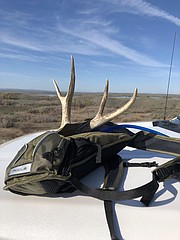Fresh sheds to be found in Basin
Just like a peacock’s long plumage, a deer’s antlers help establish hierarchies among bucks. They are symbols of physical fitness, superior genetics and dominance. It’s no wonder why humans find them appealing as well.
In Washington, according to the Department of Fish and Wildlife, bucks keep their antlers through the fall, dropping them from late December to early March due to hormonal changes -- leaving trophies for the shrub-steppe hiker to stumble upon.
There’s a market for deer antlers, sold by the pound. People use them for dog toys, art, furniture, chandeliers -- all kinds of stuff.
According to the state Department of Fish and Wildlife, antlers that have been shed and left on the ground for a few weeks will show signs of gnawing by smaller animals such as mice, rats, squirrels, hares and porcupines. Antlers supply these animals with calcium, phosphorus and other minerals while sharpening their teeth.
Many avid horn hunters will take every antler they come across, even if it is brittle and gnawed. This makes up for the times they go searching and return empty-handed.
The desert can be a vast mosaic of shades and textures. Horn hunting, then, becomes an “I spy” for certain colors and shapes.
While older horns are some of the brightest white in the shrub steppe, fresh sheds are brown as any stick.
Go up on a ridge and survey the land from above. In addition to these colors, peruse for the tip or the burr shape -- the starlike appendage that attaches to the skull. In the wild, hardly anything mimics these shapes.
As for the where, horns in the Columbia Basin can be like needles in a haystack, because deer wander all about. Take note of where the deer are in January and February, around shedding time, and then return to those areas.
A great find, of course, is a matching set.
In Washington, there are no seasons or permits needed to collect shed antlers, but horn hunters are advised to follow state regulations for land use and to follow posted closure signs.
Fish and Wildlife advises horn hunters to stay on designated trails and roads while using motor vehicles, observe from a distance and give wildlife plenty of space.
Sam Fletcher can be reached via email at sfletcher@columbiabasinherald.com.





